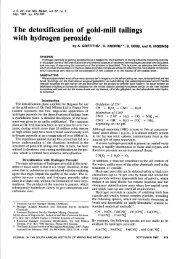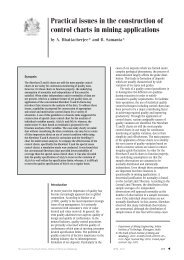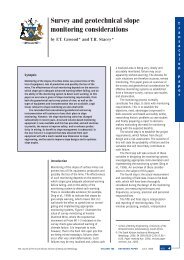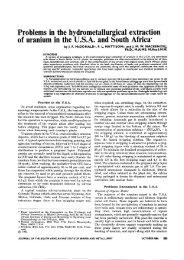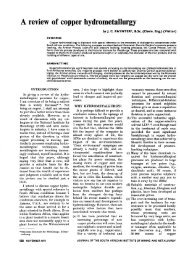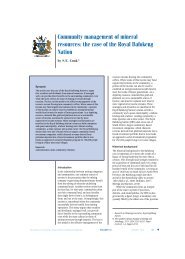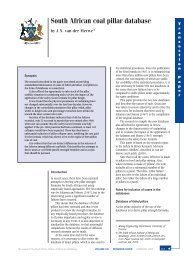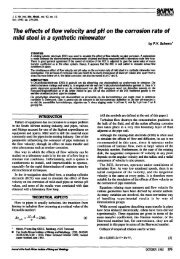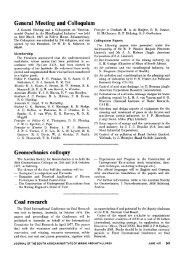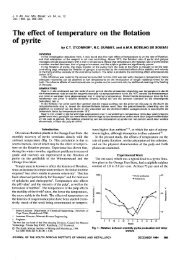The intensive cyanidation of gold-plant gravity concentrates - saimm
The intensive cyanidation of gold-plant gravity concentrates - saimm
The intensive cyanidation of gold-plant gravity concentrates - saimm
Create successful ePaper yourself
Turn your PDF publications into a flip-book with our unique Google optimized e-Paper software.
I<br />
1<br />
I<br />
When air was used, the system was open to the atmosphere,<br />
but, when oxygen was used, the vessel was sealed<br />
and oxygen was fed automatically through a pressure<br />
regulator, the pressure in the vessel being kept constant<br />
at approximately 7 to 14 kPa and oxygen being added<br />
only as it was consumed.<br />
At the end <strong>of</strong> each leaching experiment, the solids<br />
were washed by decantation as follows: the solids were<br />
allowed to settle for 15 minutes for the first two decantations<br />
and for 10 minutes for subsequent decantations;<br />
the cycle <strong>of</strong> washing and decantation was continued until<br />
a neutral wash water was obtained, after which the<br />
residue in the vessel was discharged, filtered, and dried.<br />
<strong>The</strong> on-site flotation <strong>of</strong> fourteen 1 kg samples <strong>of</strong> highgrade<br />
belt <strong>concentrates</strong> (<strong>gold</strong> 11 to 40 kg(t) by a wellestablished<br />
<strong>gold</strong>-flotation procedure yielded average<br />
<strong>gold</strong> recoveries <strong>of</strong> 88 per cent at rougher-concentrate<br />
grades averaging 48 per cent <strong>gold</strong>. <strong>The</strong> <strong>cyanidation</strong> <strong>of</strong><br />
the resulting flotation tailings (<strong>gold</strong> 0,4 to 1,9 kg(t) was<br />
subsequently carried out in the bench reactor. <strong>The</strong><br />
feasibility <strong>of</strong> floating <strong>gold</strong> direct from the bench reactor<br />
was also studied (see later).<br />
Cyanidation<br />
When a high-grade <strong>gravity</strong> concentrate (sample<br />
W4 - <strong>gold</strong> 19,4 kg(t) was leached using oxygen sparging<br />
at a liquid: solid ratio <strong>of</strong> 2:1 and controlling the temperature<br />
in the region 30 to 35 QC, <strong>gold</strong> extractions <strong>of</strong> 99,9<br />
per cent were obtained after a contact time <strong>of</strong> 4 hours<br />
(Table XII). Similarly, for concentrate flotation tailings<br />
containing 432 g(t <strong>gold</strong> (Table XIII), the overall <strong>gold</strong><br />
recoveries averaged 99,8 per cent when the flotation was<br />
taken into account. Once again, the use <strong>of</strong> oxygen would<br />
appear to be advantageous where high-grade <strong>concentrates</strong><br />
are treated directly by <strong>cyanidation</strong>, but, with<br />
lower-grade flotation tailings, air or a short period <strong>of</strong><br />
sparging with oxygen followed by air would appear to be<br />
adequate. <strong>The</strong> lowest value for residual <strong>gold</strong> obtained in<br />
the present exercise (6,9 g(t) was obtained after sparging<br />
with oxygen for 1 hour followed by aeration for 16 hours.<br />
From a technical point <strong>of</strong> view, the present investigation<br />
indicated that a very simple operation yielding<br />
exceptionally high <strong>gold</strong> recoveries is technically feasible.<br />
Direct Flotation from Reactor<br />
Sample W6 <strong>of</strong> <strong>gold</strong>-<strong>plant</strong> belt concentrate (<strong>gold</strong> 2,5<br />
kg(t) was submitted to flotation in the <strong>cyanidation</strong><br />
reactor (Fig. ll), whereby t,he excess froth was piped <strong>of</strong>f<br />
through a 25 mm plastic tube connected to the orefeeding<br />
port in the lid <strong>of</strong> the vessel. After a flotation<br />
procedure involving 25 minutes, a concentrate grade <strong>of</strong><br />
7,3 per cent <strong>gold</strong> was obtained, representing 3,9 per<br />
cent <strong>of</strong> the original mass. <strong>The</strong> <strong>gold</strong> recovery was 87,4<br />
per cent with tailings assaying 421 g(t <strong>gold</strong>. As such a<br />
flotation recovery compared very favourably with the<br />
more conventional procedure, it would appear to be<br />
recommended, especially for high-grade <strong>concentrates</strong>.<br />
Although the cyanide consumption was reduced only<br />
marginally, the <strong>cyanidation</strong> times can be expected to<br />
be considerably shorter. <strong>The</strong> possiblity <strong>of</strong> floating <strong>gold</strong><br />
direct from the <strong>cyanidation</strong> vessel thus appeared very<br />
attractive because <strong>of</strong> its simplicity and relative effectiveness.<br />
Recovery <strong>of</strong> Osmiridium from Leach Residues<br />
Three composite samples <strong>of</strong> belt <strong>concentrates</strong> designated<br />
Wl to W3 were initially leached by <strong>intensive</strong><br />
<strong>cyanidation</strong>, and the residues were tabled for the<br />
recovery <strong>of</strong> osmiridium. Approximat,ely 10 kg <strong>of</strong> each<br />
Contacttlm;;~-- --'f';mperature rise<br />
(h)<br />
(OC)<br />
3<br />
6<br />
3<br />
6<br />
4<br />
- ---J\laterial:<br />
Conditions:<br />
TABLE<br />
CYANIDATION OF BELT CONCENTRATES IN THE BENCH-SCALE REACTOR<br />
Residual<br />
(gjt)<br />
16-53 No control 124<br />
13-59 No control 270<br />
18-56 No control 67,9<br />
30-35 Controlled 939<br />
30-35 Controlled 26,9<br />
Sample W4 (19,4 kgjt, Au)<br />
Liquid: solid ratio 2:1<br />
Oxygen aeration<br />
Au<br />
Au<br />
extraction<br />
(%)<br />
99,4<br />
98,6<br />
99,6<br />
95,3<br />
99,9<br />
XII<br />
I<br />
-<br />
Added<br />
Sodium<br />
(k~<br />
Fines decanted<br />
cyanide<br />
Consumed (kgjt)<br />
~% <strong>of</strong>tota~<br />
40,0 28,0 3,8<br />
40,0 34,4 6,7<br />
40,0 31,4 6,7<br />
40,0 40,0 5,5<br />
55,7 40,5 5,2<br />
---------<br />
Contact<br />
time<br />
(h)<br />
TABLE<br />
CYANIDATION OF BELT-CONCENTRATE FLOTATION TAILINGS IN THE BENCH-SCALE REACTOR<br />
XIII<br />
Impeller<br />
I<br />
Residual Au I Sodium cyanide Fi nes<br />
Temperature Oxidizing speed Au extraction dec anted<br />
(OC) agent (rjmin) (gjt) (%) Added (kgjt) Consumed (kgjt) (%0 f total)<br />
4<br />
20-25 Air 1450 9,1 97,8 30,0 21,9 7 ,5<br />
4<br />
30-35 Air 1450 38,9 90,8 37,5 25,7 5 ,8<br />
4<br />
40-45 Air 1450 6,5 98,5 30,0 18,1 7 ,6<br />
3<br />
30-35 Oxygen 1450 9,7 97,7 30,0 18,5 7 ,2<br />
1<br />
30-35 Oxygen. 1450 9,6 97,7 35,0 25,2 7,4<br />
1<br />
30-35 Oxygen 1l00 33,8 92,0 35,0 23,5 5 ,1<br />
1<br />
30-35 Oxygen 800 15,9 96,2 35,0 24,5 5 ,8<br />
Oxygon +<br />
1+ 16* 30-35 Overni ght air 1450 69 984 ?_5,0+ 10 24,3+8,1<br />
* *<br />
---<br />
6,0<br />
*1 hour<br />
Material:<br />
<strong>of</strong> oxygen followed by 16 hours <strong>of</strong> air.<br />
Flotation tailings (432 gjt Au)<br />
Conditions: Liquid: solid ratio 1:1<br />
JOURNAL OF THE SOUTH AFRICAN INSTITUTE OF MINING AND METALLURGY JANUARY 1978 163




